| Home |
| Acknowledgments |
| Conventions |
| Glossary |
| Maps |
| References |
| Links |
| Articles |
| Thumbnails |
| Species
list |
| Family |
| Next
species |
Additional Photos
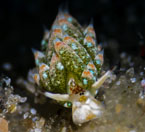
cerata detail
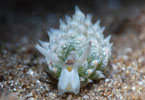
front

side

underside
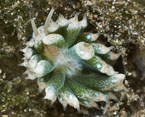
cardiac sack
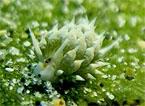
pale
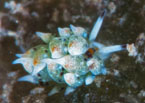
young
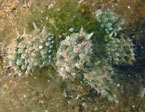
feeding

mating
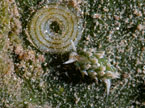
with egg mass
_______________
GALLERY

Costasiella kuroshimae Ichikawa, 1993
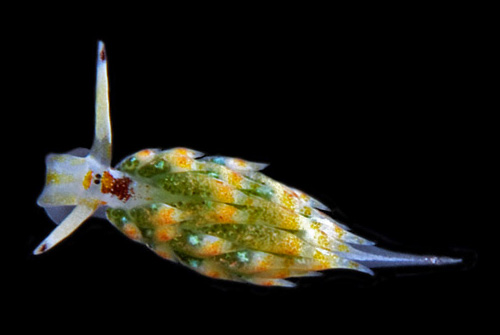
| Maximum size: about 8 mm. Identification: This species has a translucent-cream body. In bright animals, there is an irregular brick-red to black patch located behind the eye spots and the head is variously streaked with orange-brown in front of the eye spots. The rhinophores have broad medial bands of opaque white, short black lines on their dorsal tips and translucent bases. The foot, posterior to the cerata, has a broad dorsal band of opaque white. The cerata contain dense, green granules and minute iridescent flecks. Their tips are translucent followed, consecutively, (on their anterior faces) by a broad rust-brown patch and an iridescent blue patch. In some animals, additional faint orange and/or pale blue patches may be present within the translucent tips. In pale animals, the patterns on the front of the head and on the cerata may be variably obscured by superficial, cloudy-white pigment. A few dark, olive-brown spots may occur below the blue patch in the lateral cerata (primarily in young animals). Natural history: In the field, Costasiella kuroshimae is known from numerous animals found at 7-15 m (24-49 ft) on Avrainvillea erecta, most in association with Costasiella fridae and/or Costasiella sp. #3. (see photos) Rarely, it may be found in < 3 m (< 10 ft). It's diurnally active and lays a spiral egg mass on its host algae. Freshly laid eggs are translucent-white but some older egg masses develop a ring of urine-yellow pigment on the outer margin of the ribbon or yellowish-green patches on their upper surfaces (Note 1) Distribution: Big Island, Maui, Oahu and Kauai: widely distributed in the Indo-Pacific. Taxonomic notes: It was first recorded in Hawaii from a flow tank at Kewalo Marine Laboratory, Oahu by Narrissa Spies & James Murphy on Jan. 29, 2014. The Hawaiian animals closely match the original description of C. kuroshima. However, animals listed under that name from elsewhere in the Indo-Pacific may include multiple species. There remains some possibility that bright and pale animals could be split. However, the range of variation in color parallels the range of variation illustrated in Gosliner, et. al. (2018) and elsewhere (when the animals considered are limited to those with comparable markings on their rhinophores). Also, apparent intergrades between bright and pale forms occur elsewhere. Since its food algae, Avrainvillea erecta, is thought to be introduced there's some chance that this species is, as well. Photo: Narrissa Spies & James Murphy: some cerata autotomized?: 4.5 mm: found in flow tank at Kewalo Marine Laboratory, Oahu; Jan. 29, 2014. Observations and comments: Note 1: Recent closeup photos by Katherine Shepherd show what appear to be micro-algae overgrowing some egg masses. Reexamination of older photos also reveled a hint of "granularity" in yellow-green areas. Perhaps, the more uniform, urine-yellow pigment on the outer faces of the whorls in some masses might be micro-algae confined to those areas (or, a different colonizing species)? (see photos) |
| Thumbnails |
Species
list |
Family | Next species | Top |